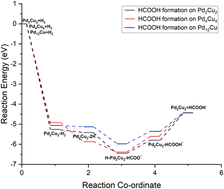CO2 hydrogenation to formic acid on Pd–Cu nanoclusters: a DFT study†
Abstract
Carbon dioxide (CO2) hydrogenation to formic acid is a promising method for the conversion of CO2 to useful organic products. The interaction of CO2 with hydrogen (H2) on PdmCun (m + n = 4, 8 and 13) clusters to form formic acid (HCOOH) has been explored using density functional theoretical (DFT) calculations. Pd2Cu2, Pd4Cu4 and 13-atom Pd12Cu clusters are found to be the most stable among all of the PdmCun (m + n = 4, 8 and 13) clusters with binding energies of −1.75, −2.16 and −2.40 eV per atom, respectively. CO2 molecules get adsorbed on the Pd2Cu2, Pd4Cu4 and Pd12Cu clusters in an inverted V-shaped way with adsorption energies of −0.91, −0.96 and −0.44 eV, respectively. The hydrogenation of CO2 to form formate goes through a unidentate structure that rapidly transforms into the bidentate structure. To determine the transition state structures and minimum energy paths (MEPs) for CO2 hydrogenation to formic acid, the climbing image nudge elastic band (CI-NEB) method has been adopted. The activation barriers for the formation of formic acid from formate on Pd2Cu2 and Pd4Cu4 are calculated to be 0.79 and 0.68 eV, respectively whereas that on the Pd12Cu cluster is 1.77 eV. The enthalpy for the overall process of CO2 hydrogenation to formic acid on the Pd2Cu2, Pd4Cu4 and Pd12Cu clusters are found to be 0.83, 0.48 and 0.63 eV, respectively. Analysis of the density of states (DOS) spectra show that the 4d orbital of Pd, the 3d orbital of Cu, and the 2p orbitals of C and O atoms are involved in the bonding between CO2 molecules and the Pd2Cu2 clusters. The CO2 adsorption on the PdmCun (m + n = 4 and 8) clusters has also been explained in terms of the charge density distribution analysis.

- This article is part of the themed collection: Stability and properties of new-generation metal and metal-oxide clusters down to subnanometer scale


 Please wait while we load your content...
Please wait while we load your content...